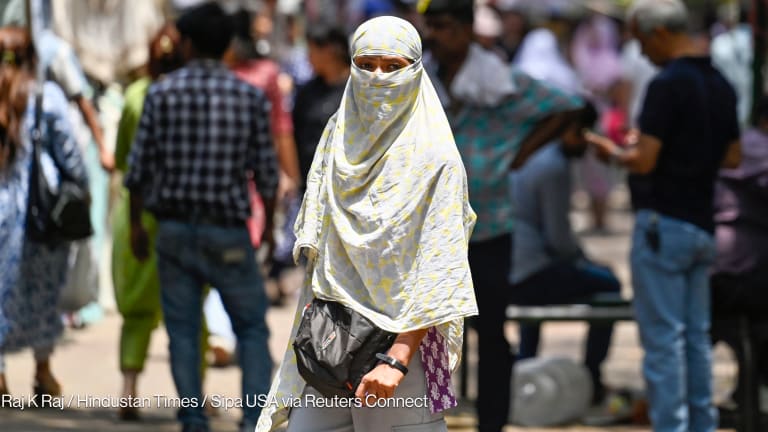
The World Health Organization is set to release its estimates of excess deaths caused by COVID-19 in early April, the global health body has confirmed to Devex. The excess mortality estimates will account for both direct and indirect impacts of the pandemic, and the figure is more than double the official death toll of 6 million, Devex has learned.
The estimates were produced as a collaboration between the United Nations Department of Economic and Social Affairs, WHO, and a WHO technical advisory group set up for this purpose.
While WHO has said the process was collaborative and member states were involved and consulted, it is bracing for pushback, especially from countries such as India. According to a TAG member who was privy to the process, the Indian government does not agree with the estimates shared by WHO which are at least four times the official figure, which currently stands at 521,101 deaths.
Asked how WHO plans to tackle India’s response, a spokesperson told Devex there were efforts to “engage actively with Indian officials” to address their questions. “While WHO is doing everything to work to address concerns, this must be balanced against WHO’s obligation to publish health statistics. Therefore, the estimates will be published, but noting India’s reservations,” the spokesperson told Devex via email.
The must-read weekly newsletter for exclusive global health news and insider insights.
The TAG member, who spoke on the condition of anonymity as they were not authorized to comment on the topic, also said that the Indian government had asked for the estimates to be published “10 years later.”
“It would be irresponsible to say, let’s wait until the pandemic is over, then we will reflect,” the WHO spokesperson said in response to Devex’s question about India’s demand while reiterating that the agency will be publishing the estimates next month. “If lessons can be learned now, if lives can be saved now, then we have a responsibility to learn those lessons, and save those lives now.”
The Indian health ministry had not responded to Devex’s questions at the time of publication.
By the numbers
WHO Division of Data, Analytics and Delivery for Impact started the process of calculating COVID-19 excess mortality estimates in February 2021.
“The excess mortality estimates associated with Covid-19 provide a more comprehensive measure of the impact of the pandemic. The direct measure (deaths directly attributable to Covid) provide only a limited, and in many cases problematic measure,” the WHO spokesperson said.
To support WHO and U.N. DESA, the TAG was set up — comprising 33 members, and observers including experts from all over the world in the fields of epidemiology, demography, and statistics.
As part of the process, WHO invited all member states to nominate a point person to engage with the organization, submit any data they felt was relevant to the exercise; and nominate national experts to the TAG. WHO “also conducted a series of regional and global consultations to keep Member States abreast of developments. We also had bilateral meetings with, or provided detailed information to, any countries that requested additional information or clarifications,” the spokesperson said.
WHO member states were invited to share data and were kept updated on the methodology.
“In the Indian case, no one believes that the official toll is around 500,000. Even government officials would grudgingly say it’s higher than the official figure.”
— Prabhat Jha, director, University of Toronto’s Centre for Global Health Research“Our goal was to achieve as high a level of transparency and engagement as possible. Moreover, we have reassured countries that this series will be updated as new data become available,” the WHO spokesperson said.
But what if member states still oppose the estimates once the announcement is made?
“WHO is mandated to produce high quality, impartial statistical estimates. Given the global nature of the pandemic, it is critical that excess mortality estimates are produced for every country, so that a global estimate can be produced,” the WHO spokesperson said, adding that the estimates will also be important for the work of other U.N. agencies, not just WHO. “Should any countries object to the WHO estimates, this will be clearly flagged in the report,” the spokesperson said.
WHO is also careful to point out that the estimates are not absolute numbers. “It’s important to remember that these are estimates … and each estimate is accompanied by a range of uncertainty,” the spokesperson said.
Speaking to Devex in 2021 about the process, Samira Asma, assistant director-general for the Division of Data, Analytics and Delivery for Impact at WHO, said that the onus of publishing data lies with individual governments, which can then use the data to prepare for and anticipate future situations.
Devex CheckUp: Could an IP waiver have averted millions of deaths?
In this week's edition: how intellectual property protections have impacted COVID-19 deaths, Africa CDC’s future, and new maternal mortality targets.
“So the situation is not that the government is good or bad, but there’s been a lack of visible investment and prioritization in health info systems,” she said. “So I think the lessons that we’re learning we better learn fast and not wait.” The focus of the exercise is not simply to measure the number of excess deaths, she noted, but also to bring about improvements in civil registration and vital statistics systems across the world.
India’s track record
The Indian government has had a history of refuting researchers’ claims — and has reacted negatively to past studies on excess mortality.
One such study published in Science, led by Dr. Prabhat Jha, director of the Centre for Global Health Research at the University of Toronto, was raised in India’s Parliament earlier this year by the opposition party. In response, the Indian minister of health dismissed the study as “speculative” and accused it of using “non-validated methodology.”
Earlier this month, The Lancet also published a study in which researchers stated that the global death toll is estimated to be 18.2 million and that India’s death toll is 4.07 million — eight times higher than the number of COVID-19 deaths the country has officially registered. The claims of the study were also refuted by the Indian government, which released a statement calling it “speculative and misinformed.”
Speaking to Devex in New Delhi, Jha, who is also a member of the TAG, stated that a large number of deaths in India are simply not recorded. Out of 10 million deaths that occur annually, 30%are not registered, he said, which he noted is a problem that predates COVID-19.
“In the Indian case, no one believes that the official toll is around 500,000. Even government officials would grudgingly say it’s higher than the official figure,” Jha said. His research shows that underreporting in India is between five to eight times the official number.
WHO’s model uses civil registration data, Jha said, which avoids the problem of model-based estimates such as the ones used in The Lancet study, among others. But the lack of data from the ground is an issue that needs to be resolved, he believes.
“Without data, you’re flying blind. That’s often lost in a political environment [that says] ‘don’t criticize us.’ That is my concern going forward that the lessons learned about counting the dead should not be forgotten,” he said.
One of Jha’s recommendations is to include a question about deaths in the forthcoming census, not just in India but in other countries as well.
Ariel Karlinsky, a data scientist from Israel who co-created the World Mortality Dataset and is part of the TAG, said that some countries didn’t take favorably to the exercise because they feel “it’s either blaming them for incompetence or for obfuscation of data.”
The challenges in collecting data were different across countries. While some member states, a majority in Africa, don’t have the capacity to register deaths, there were also countries that refused to share data they do collect on a regular basis.
Pakistan, for example, did not give WHO any data related to excess deaths, Karlinsky said. “In Turkey too, they have the data and the ability to produce the numbers, but they’ve stopped the process,” he said. In such cases, WHO relied on projecting estimates along with triangulating them with “boots on the ground” reporting, he added.
Publishing the estimates is a crucial step, he believes. “Without this, people will rely on officially reported COVID mortality data which is an undercount in many many many many many countries,” he told Devex.
Asked in 2021 if she was anticipating any pushback from countries, Asma said, “The way WHO works with our member states, our job is not to please anybody. Our job is to present the right evidence.”









